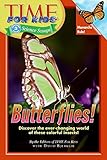Lesson 3: Proving Facts and Forming Opinions
Lesson Plan
Time for Kids: Butterflies!

- Learning Goal
- Locate and verify facts in nonfiction.
- Create and identify opinions based on facts from a text.
- Duration
- Approximately 50 minutes
- Necessary Materials
-
Provided: Direct Teaching and Guided Practice Worksheet
Not Provided: Time for Kids: Butterflies! with David Bjerklie, chart paper, markers, lined paper, nonfiction books from classroom or school library
-
Teacher Modeling

will explain that today we are going to use some of the resources we have been learning about to identify fact and opinion statements. I will use Time for Kids: Butterflies! to model this, using the first two sentences on the chart. (Direct Teaching and Guided Practice Worksheet provided below in Teacher and Student Materials.) I will model how to use chapter names, headings, and skimming for key words to locate facts for proof. I will model how to create opinion statements based on these facts.
-
Think Check
Ask: How did I distinguish facts from opinions in a text? Students should respond that you looked at the sentence and then found the "proof" in the text that proves it to be a fact. You then identified which sentences could not be proven because it was a thought or feeling.
-
Guided Practice

will determine if the remaining sentences on the chart are facts or opinions. We will use textual features from the book to find the facts and to prove that they are true. We will develop an opinion about the book.
-
Independent Practice

will use a book where facts can be found and write 4 facts from the book and create 4 opinion statements about the topic. You will trade papers with a partner and identify which statements from your partner’s paper are fact and opinion. You will prove the facts by finding the information in the book and recording the page.
Texts & Materials
Standards Alignment
(To see all of the ReadWorks lessons aligned to your standards, click here.)


So as a teacher, will use one book to model, what about the students? should they be using the same book? or they can choose whatever non-fiction book to find out facts from and form their opinions about it?
Thank You!
I am astonished by the superb quality of the work on this site. Every teacher implementing Common Core needs to use these lessons and strategies. Thank you for an amazing job with content and organization!
This is a great resource! I love how the lessons are organized.